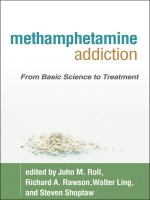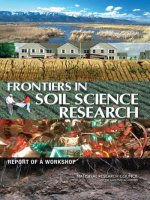Ch 03 basic soil science
Bạn đang xem bản rút gọn của tài liệu. Xem và tải ngay bản đầy đủ của tài liệu tại đây (3.72 MB, 59 trang )
Mid-Atlantic
Nutrie nt Manag e me nt
Handbo o k
Chapte r 3.
Co nc e pts o f Bas ic S o il S c ie nc e
W. Le e Danie ls and Kathryn C. Hae ring , Virg inia Te c h
Po we rPo int pre s e ntatio n pre pare d by Kathryn Hae ring
Soil formation and soil horizons
Volume composition of a desirable surface soil
50%
pore
space
25% air
25% water
45 to 48%
mineral
matter
50%
solid
material
2 to 5% organic matter
Soil parent material and weathering
The mineral material of a soil is the product of the weathering of
underlying rock in place, or the weathering of transported sediments or
rock fragments.
The material from which a soil has formed is called its parent material.
The rate and extent of weathering depends on:
the chemical composition of the minerals that comprise the rock or
sediment
the type, strength, and durability of the material that holds the
mineral grains together
the extent of rock flaws or fractures.
the rate of leaching through the material
the extent and type of vegetation at the surface
Soil horizons
Principal (master) soil horizons found
in managed agricultural fields are:
A horizon or mineral surface soil (if
the soil has been plowed, this is
called the Ap horizon).
B horizon or subsoil.
C horizon or partially weathered
parent material.
rock (R) or unconsolidated parent
materials similar to that from which
the soil developed.
A
E
B
C
Unmanaged forest soils also
commonly contain:
O (organic) horizon on the surface
E (eluviated) horizon: a lightcolored leached zone just below the
A horizon.
Jim Baker, Virginia Tech
Surface soil horizons: Ap or A + E
Ap or A+ E horizons:
Contains more organic matter than the
other soil layers.
Often coarser than the subsoil layer.
A or Ap horizon tends to be more
fertile and have a greater concentration
of plant roots than any other soil
horizon.
In unplowed soils, the eluviated (E)
horizon below the A horizon is often
light-colored, coarser-textured, and
more acidic than either the A horizon or
the horizons below it, because of
leaching with time.
Ap
Lynn Betts, USDA-NRCS
Subsurface soil horizons: B
B horizon:
Typically finer in texture, denser,
and firmer than the surface soil.
Organic matter content tends to
be much lower than surface layer.
Subsoil colors are often stronger
and brighter: shades of red, brown,
and yellow predominating due to
the accumulation of iron on clays
and other particles.
Bt horizon: Subsoil layers with
high clay accumulation relative to
the A horizon.
Bt
Jim Baker, Virginia Tech
Subsurface soil horizons: C
C horizon:
Partially decomposed and weathered
parent material that retains some
characteristics of the parent material.
More like the parent material from
which it has weathered than the
subsoil above it.
C
USDA-NRCS
Idealized soil profile
Soil physical properties and organic matter
Soil particles
Sand:
Particles range in size from
very fine (0.05 mm) to very
coarse (2.0 mm) in average
diameter.
Most particles can be seen
without a magnifying glass.
Feel coarse and gritty when
rubbed between the thumb
and fingers, except for mica
flakes.
Sand texture
(Photo by Jim Baker, Virginia Tech)
Soil particles
Silt:
Particles range in size from
0.05 mm to 0.002 mm.
Cannot usually be seen by
the unaided eye
When moistened, silt feels
smooth but is not slick or
sticky. When dry, it is
smooth and floury
Silt loam texture
(photo by Jim Baker, Virginia Tech)
Soil particles
Clay:
Particles are finer than 0.002
mm.
Can be seen only with the
aid of an electron
microscope.
Feels extremely smooth or
powdery when dry, and
becomes plastic and sticky
when wet.
Clay texture
(Photo by Jim Baker, Virginia Tech)
The USDA textural triangle
Soil structure
Soil aggregation is the cementing of several soil particles into a
secondary unit or aggregate.
Soil particles are grouped together during the aggregation process to
form structural units (or peds).
These units vary in size, shape, and distinctness (also known as
strength or grade).
The structure of the soil affects pore space size and distribution and,
therefore, rates of air and water movement. Well-developed structure
allows favorable movement of air and water, and root development.
Types of structure: Granular and Blocky
Granular:
Soil particles are arranged in small, rounded units.
Common in surface soils (A horizons).
Most distinct in soils with relatively high organic matter content.
Granular
Prismatic
Blocky
Structureless:
massive
Jim Baker, Virginia Tech
Types of structure: Granular and Blocky
Blocky:
Soil particles are arranged to form block-like units, which are about
as wide as they are high or long.
Some blocky peds are rounded on the edges and corners; others
are angular.
Blocky structure is commonly found in the subsoil, although some
eroded fine-textured soils have blocky structure in the surface
horizons.
Blocky
W. Lee Daniels, Virginia Tech
Granular
Prismatic
Types of structure: Platy
Platy:
Soil particles are arranged in plate-like sheets, which are
approximately horizontal in the soil and may occur in either the
surface or subsoil, although
they are most common in the subsoil.
Structureless:
Blocky
Platy structure strongly limits
massive
downward movement of water, air,
roots and may result from compaction.
Platy
Structureless:
single grain
Jim Baker, Virginia Tech
ar
y
Types of structure: Prismatic
Prismatic:
Soil particles are arranged into large
peds with a long vertical axis.
Well developed subsoil prisms are
associated with fragipans (dense subsoil
layers), or soils that swell when wet and
shrink when dry, reducing air and water
movement.
Most clayey subsoils exhibit prismatic
macro-structures to some extent.
Prismatic
Jim Baker, Virginia Tech
Structureless:
Granular
Prismatic
Types of structure: Structureless
Structureless:
Two types:
•Massive:
Blocky no definite
structure or shape, as in
some C horizons or
compacted material.
•Single grain: typically
individual sand grains in A
or CPlaty
horizons not held
together by organic matter
or clay.
Structureless:
massive
Structureless:
single grain
Soil porosity and bulk density
Soil porosity, or pore space, is the volume percentage of the total soil
that is not occupied by solid particles. Pore space is commonly
expressed as a percentage:
% pore space = 100 - [bulk density ÷ particle density x 100]
Bulk density is the dry mass of soil solids per unit volume of soils.
Particle density is the density of soil solids, which is assumed to be
constant at 2.65 g/cm3.
Bulk densities of mineral soils are usually in the range of 1.1 to 1.7
g/cm3. A soil with a bulk density of about 1.32 g/cm 3 will generally
possess the ideal soil condition of 50% solids and 50% pore space.
Under field conditions, pore space is filled with a variable mix of water
and air:
If soil particles are packed closely together, total porosity will be low
and bulk density will be high.
If soil particles are arranged in porous aggregates, total porosity will
be high and bulk density will be low.
Soil porosity: Macropores and micropores
The size of the individual
pore spaces, rather than their
combined volume, will have
the most effect on air and
water movement in soil.
Pores smaller than about
0.05 mm (or finer than sand)
in diameter are typically called
micropores.
Pores larger than 0.05 mm
are called macropores.
macropores
micropores
Soil porosity: Macropores and micropores
Macropores allow the ready movement of
air, roots, and percolating water.
Movement of air and water through a
coarse-textured sandy soil is often rapid
despite its low total porosity because of
the dominance of macropores.
Micropores in moist soils are typically filled
with water, and this does not permit much air
movement into or out of the soil.
Movement of air and water through a fine
textured clay soil may be slow (see
picture at right) despite high total porosity
because of the dominance of micropores.
Jim Baker, Virginia Tech
Soil organic matter
Soil organic matter:
Plant and animal residues in various
stages of decay.
Sources: dead roots, root exudates, litter
and leaf drop, and the bodies of soil
animals such as insects and worms.
Primary energy and nutrient source for
insects, bacteria, fungi, and other soil
organisms.
After decomposition, nutrients released
from the residues available for use by
growing plants.
Soil humus:
Fully decomposed and stable organic matter.
Most reactive and important component of soil organic matter.
Form of soil organic material that is typically reported as “organic
matter” on soil testing reports.
Factors affecting organic matter content
Type of vegetation:
Soils under grass generally have a
relatively high percentage of organic
matter in their surface.
Soils that develop under trees often
have a low organic matter percentage in
the surface mineral soil, but do contain a
surface litter layer (O horizon).
Organic matter levels are typically
higher in a topsoil supporting hay,
pasture, or forest than in a topsoil used
for cultivated crops.









